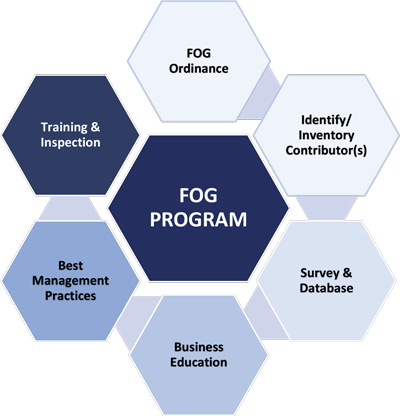Posted by Tori Morgan on Tuesday, January 25, 2022
I LOVE FOG programs. I know, it’s weird and I’m ok with that.
Over the years, I’ve helped develop dozens of FOG Programs for all sized wastewater systems across the country. I love doing it because each one is unique, specifically crafted to the needs of that system. Some were small and simple so that the client could manage everything themselves and track their progress with an Excel spreadsheet. Others were more robust and/or grew over time as the owner saw positive results and the value of the program. Most importantly, all of them made a difference to enhance system operations and better the environment.
Other FOG Sources:
- lard/fats
- soups/gravy
- mayonnaise
- pastas
- seeds
The FOG Basics: Who, What, Where, & How?
Fats, Oils, & Grease, aka FOG, are the wastes and unwanted byproducts from food preparation activities at a restaurant or in a commercial kitchen found in various institutions (schools, industries, hospitals, long-term care institutions). It is also produced in our own homes, coming from the remnants of meats, fish oils, nuts, plant/vegetable oils, dairy products, salad dressings, sauces, butter, margarine, and even certain fruits. FOG is usually a liquid when heated, then a solid or semi-solid state once cooled.
The FOG Problem
If FOG gets down the drain and into the sewer unimpeded, it presents two main problems:
- Coagulating & Clogging Sewers
Nobody likes a clogged pipe. And FOG is especially good at sticking to pipes, and collecting more and more FOG and non-FOG materials alike. A clog will eventually lead to a backup or overflow of untreated sewage. Yuck! Not something you want in your street or restaurant and clean-up/unclogging is costly. - Treatment Plant & Effluent Issues
FOG that makes it through the pipes will collect at the last stop – the treatment plant. There it’s an operational nightmare, needing to be physically removed and negatively impacting treatment and in-turn the effluent’s quality leaving the plant and returning to the environment.
The FOG Solution
Hopefully, I’ve villainized FOG enough that you’re ready to join the fight to defeat FOG! But, like all villains, FOG will not go down without a fight. Fortunately, there are many tools we can use against FOG, like grease traps, grease interceptors, maintenance, treatment, inspections, Best Management Practices (BMP’s), and education. Assembling your weapons and strategies at the authority or municipal level to customize your FOG fight is the crux of a strong FOG Program.
Getting Started With a FOG Program
To get started, here are a few key questions to answer:
- What prompted this discussion about FOG?
- What and where are the FOG issues in your collection system?
- Are there complaints about overflows, or has this become an insurance liability or regulatory compliance issue?
- What kind of FOG mitigation program do you have in place now?
- Is there recent or upcoming business growth in your system? Particularly for restaurants, educational, or hospital facilities with food services?
- Is an ordinance in place detailing requirements for maintenance and inspections of grease traps and interceptors, plus fees and fines to help enforce a FOG program?
Focusing Your FOG Program

Key Steps to a successful FOG Program.
The backbone of a Program is the FOG Ordinance, which outlines the expectations, limits, compliance standards, and enforcement for the community. It is imperative that this legal document is in place to support the activities of the FOG program.
Once there’s a comprehensive understanding of the collection system and issues, a good place to focus is on an inventory of the food service establishments, since they generate the bulk of the fats, oils, and grease.
The educational piece is key, and can simply start with businesses located in the 'hot (or trouble) spots' in the collection system. Contacts are made with the businesses, then an educational program implemented to ensure they understand their role in creating, collecting, and preventing FOG, and that they know how their own system works and needs to be monitored, maintained, and cleaned on a regular basis.
Site visits are absolutely necessary, and I value them highly. I often work with the utility to conduct site visits with hands-on training and education for the food services staff. They also allow opportunity to deliver and review educational binders with drawings and diagrams, and flyers with BMPs to prevent FOG. Cape Fear Public Utility Authority created an excellent video that illustrates how education, BMPs, and training can work together. FOG education shouldn’t stop in the kitchen; it extends to the property managers, plumbers and grease hauler vendors that service the area, creating a team approach to support an effective program.
FOG Follow-Up
Watch our FOG Roundtable System owners and engineers share their experiences tackling FOG.
How do you know it’s all working? Well, there are fewer issues in your collection system linked to FOG, less problems at the plant, and fewer sanitary overflows and backups into homes and businesses, ultimately saving your system time and money.
Do you think your system would benefit from a FOG program? Or do you just want to learn more about FOG, FOG Programs, education & ordinances… well then you’ve found the right lady! Remember, I LOVE FOG Programs! And I’d LOVE to talk with you!
Tori Morgan, LO
compliance coordinator
contact get a free evaluation FOG webpage
Categories: Municipal Infrastructure
Tagged: Wastewater | Municipal Engineering